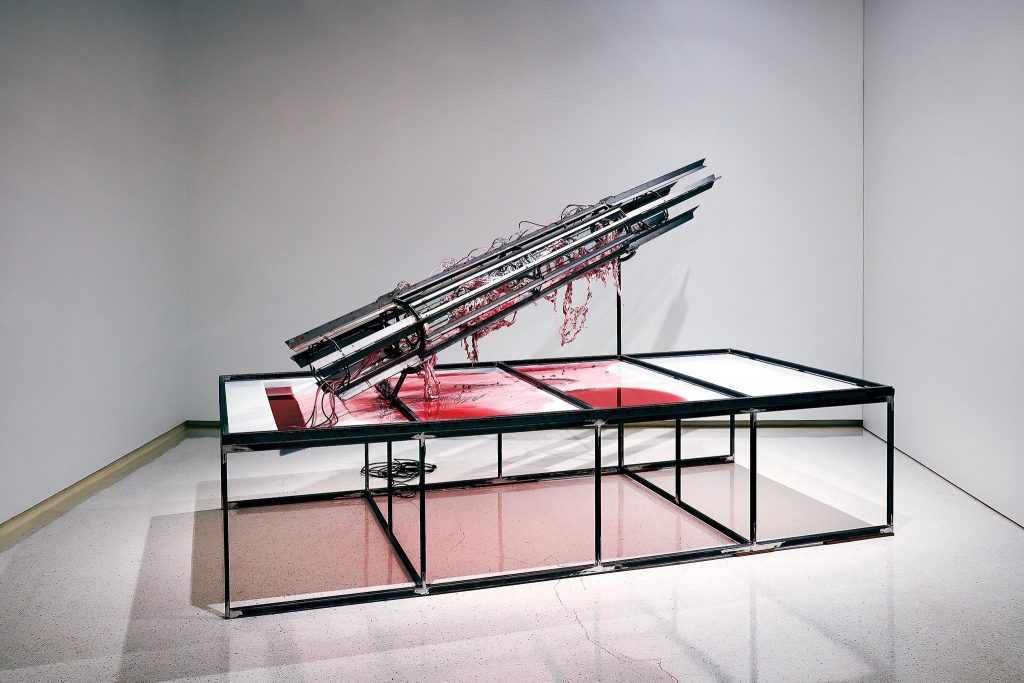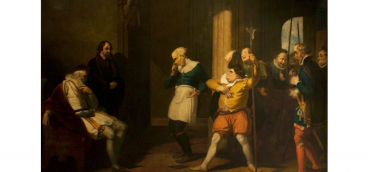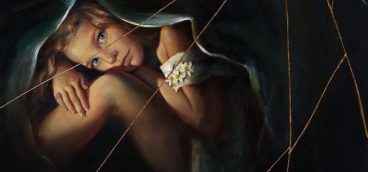The War Against Aesthetics in Contemporary Art

Often when I walk through a gallery of contemporary art, I can hear a murmuring between the works that echoes journalist Herbert Morrison’s voice describing the crash of the Hindenburg in 1937: “Oh, the humanity!” It’s as if the depiction of suffering in any form has become the criteria by which we judge art, rather than the art itself. The greater the pathos — and often, the bathos — the more worthy the work, and of course, the more the artist is esteemed.
We are certainly living in an age which celebrates tragedy — not in the form conceived by the ancient Greeks, who saw art, according to the 19th-century philosopher Friedrich Nietzsche, as the only thing that can turn “thoughts of repulsion at the horror and absurdity of existence into ideas compatible with life … the sublime.” But rather, through our contemporary moralistic lens, popular culture views tragedy as a sign of victimhood, defeat, and ultimately, as that which is the opposite of the sublime: the sentimental.
In the case of the 58th Carnegie International, currently installed throughout the Carnegie Museum of Art, the artworks didn’t need to whisper their lament during the press tour, as the three curators of the exhibition led us from piece to piece, describing in detail the suffering witnessed, endured, or recorded by the various artists, while hardly anything was said about the art itself. It was like walking through the Sistine Chapel with the guides commenting only on the religious aspects of Michelangelo’s stunning artistic achievement.
According to the exhibition catalog — a prolix, 420-page monster, with more text than art — the curatorial purpose of this show is to “negotiate transnational networks of artistic solidarity and the multigenerational weight of our entangled inheritances.” I’m not sure what this means (more on the curator’s fuzzy use of language below), but it sounds like the verbal equivalent of a painting placed in a frame that obscures the work instead of enhancing it. Gone are the days when a major exhibition meant seeing art that represents the best of the current cultural moment. Now, shows are based on specific, moralistic paradigms, with the aesthetic impact enervated by proscribed didactic goals. One might well ask, is the desideratum of art even meant to be artistic anymore? And thus, follows the question: Is the purpose of art to make us think, or rather, to tell us what to think? You can feel this agon trembling throughout the walls not only of the International but many such exhibitions today.
However, this is an ancient dilemma, and one that is often dictated by political and commercial motivations. Procuring commissions, and/or avoiding censure from state and religious institutions, have been toxic hardships facing artists for centuries, if not millennia. Even the greatest painters succumb to such pressures to achieve acceptance or survival. As one critic recently pointed out regarding the current Murillo exhibition at the Kimbell Art Museum in Texas, many works produced by this 17th century Spanish master are guilty of “abrasively moralizing.”
Ironically, only a few steps away from the International installation in the Carnegie Museum is a permanent gallery devoted to the Aesthetic Movement of the 1860s-1890s, which, as the wall panel describes, advocated l’art pour l’art, or “art for art’s sake,” and “defied the long-held belief that art should serve moral or didactic purposes.” With so much of the International devoted to the moral and didactic, one might ask: Have we returned to pre-19th century mores, when — to paraphrase the poet Michael Wurster — art had to be about something, rather than just be something?
But one could also ask, what about Picasso’s “Guernica” (1937), which is arguably one of the most powerful paintings of the 20th century? Is it not a moral painting? Does it not indict the Nazis, who were responsible for the horrific bombing of this eponymous city during the Spanish Civil War? And does such a painting not justify all moralistic artworks that protest similar abominations of humanity? But the answer to the last question would have to be emphatically no, because “Guernica” is not just a moralistic painting; it is a sublime painting that happens to have a moralistic component.
This is a crucial distinction and, I would further argue, the sublime is the quality that makes all art, poetry, music, theater, or any creative act strong. And this is also why there are relatively so few sublime works, while there are myriad moralistic ones. Indulging in the moral is easy; achieving the sublime is difficult. Let’s consider the very simple definition of sublime in the Oxford Dictionary: “Of such excellence, grandeur or beauty as to inspire great admiration or awe: as Mozart’s sublime piano concertos.” Notice the example given. When we attempt the sublime, we’re competing with Mozart. The definition could just as well have cited Miles Davis. Or Shakespeare.
Few pieces in the current International fit this definition. One reason is that an overwhelming number of them require an explanation to be understood. (It doesn’t help that many of these commentaries, called “didactic texts” in museum parlance, are written in overwrought, academic-speak, the kind of prose often found in graduate-student papers). Which raises the question: Should art speak, or do we need to speak for it? In the literary world, writers are taught the maxim, “Show, don’t tell,” and this is equally good advice for artists. There is nothing more off-putting than to be told what to think, and nothing more ironic for a show that celebrates, according to the catalog essay by curator Sohrab Mohebbi, “a historical ground for the movements of images, ideas, objects, and people that incite emancipatory expressions and artworks.” This might be the most convoluted way possible to say, simply, “the free expression of art.”
For example, Ali Eyal’s “Where Does a Thought Go When It’s Forgotten? And” (2019-22) is a series of painted manila envelopes covering several walls that is so prosaic one might walk by and never notice them, let alone see them as art; however, in the explanatory wall label the work is rationalized as emblematic of something that “can be filed away in much the same manner as forlorn bureaucratic records of the irrecoverable.” In other words, not only is this creation devoid of the aesthetic; it doesn’t even qualify as metaphoric as it never rises above the level of the tautological.

Walking further through the show, it becomes difficult to comprehend the basis for inclusion; it’s so subjective, there is clearly no aesthetic standard. So, returning to curator Mohebbi’s essay, I hoped to find a criterion. He states, “This iteration of the International attempts to encourage conversations around a range of actual and representational operations — migration, appropriation, expropriation, and decolonization — and to address culture’s resistance to the disruptions and dislocations generated by these interventions and their lasting effects.” This sounds more like an economics thesis than the mission statement of an art exhibition. Ironically, in one of his few references to aesthetics, Mr. Mohebbi elaborates:
“When the habitual collapses, we question the reason and value of what we have been doing, and why we have been doing it that way: Can we do it differently? Can we do it better? Should we give it up altogether? These are aesthetic questions. These are fundamental and existential questions that we usually forget to ask except in the face of tragedy — and art.”
However, these are really issues of moralism. It’s as if he’s compelled to entertain the word “aesthetic,” like an uninvited guest on his doorstep who he doesn’t want to let enter the party, but tells everyone he invited.
Mr. Mohebbi bases much of the rationale of his curatorial ethos on remarks made by the 20th century French philosopher Michel Foucault. This may explain the rococo fogginess of his own language, for which this era of French philosophy is famous. Such writing — a kind of hieratical style bordering on the nonsensical — originated with the 18th-century philosopher Immanuel Kant, and has infected scholarly texts ever since. It’s a kind of purposeful obscurantism, which allows a writer to sound authoritative, and hopefully profound, but often utilizes language that evades all concrete meaning. Thus, Mr. Mohebbi quotes Foucault’s definition of the creative experience as “wrenching the subject from itself, of seeing to it that the subject is no longer itself, or that it is brought to its annihilation or its dissolution.” Again, I’m not sure what this means, but it seems a fitting — if not arbitrary — ideology for an exhibition that cannot seem to be understood without explaining itself. And yet, once having explained itself, it remains unfathomable.
Notwithstanding, Foucault was indeed often profound and, if we look at his writings on art, specifically his essay on the great 17th-century Spanish painter Velázquez, we can find an insightful passage on the relationship of art to language, when he states, “But the relation of language to painting is an infinite relation. It is not that words are imperfect, or that, when confronted by the visible, they prove insuperably inadequate. Neither can be reduced to the other’s terms: It is in vain that we say what we see; what we see never resides in what we say.”
Nietzsche, whose writings were particularly influential on Foucault, wrote something very illuminating on this matter, “That which we find words for is something already dead in our hearts,” and this may explain the zombie-like character of many pieces in the show, which do not seem to live without the flesh of elucidation. Not a good requirement for visual art.
Mr. Mohebbi’s essay — which becomes an exegetical bouillabaisse of disparate citations — also quotes contemporary Korean/German philosopher Byung-Chul Han, who posits that “art contains negativity … which is the invigorating force of life … and is the essence of beauty. Beauty is illness.” So, we’re a long way from Romantic poet John Keats’ declaration that “Beauty is truth, truth beauty,” as well as the popular Victorian expression, “Beauty is in the eye of the beholder.”
And perhaps this illness conceit is why the show feels so queasy, with several works incorporating wet, uliginous features such as Mire Lee’s “Untitled (My Pittsburgh Sculpture)” (2022), comprising a long, octagonal skeletal mechanism that looks like the inside of a Gatling gun — driven by a motor — which appears to be masticating strips of synthetic flesh, and drips a blood-like liquid onto an elevated white surface. It’s the old meat grinder trope we’ve seen many times before, evoking the same tired, gory response.
It’s easy to shock by being shocking. Just show a picture or image of something reprehensible and viewers will be affected in a predictable manner. But much more challenging is to cause this effect through aesthetics, by showing something no one has conceived before, and allowing the viewer to formulate his or her own response. Like Picasso’s iconoclastic painting “Les Demoiselles d’Avignon” (1907), which so distorted the form of the human body it shocked society, and couldn’t be publicly exhibited for nine years, until the prevailing zeitgeist started to catch up with him. This is achieving the sublime.
But perhaps it’s not surprising that we are confronted by an exhibition which utilizes a definition of beauty as illness; we have been in a relativist vortex on this matter since the Enlightenment, when philosophers such as David Hume and Kant wrested the classical, objective view of beauty from Plato and Aristotle, by arguing that it is subjective, based on the experience of the person beholding the art, and is not inherent in the form of the object being perceived. As Cole Porter has presciently observed, “But now, God knows, anything goes.”
Lest I sound like a Picasso apologist, let me further my thesis by criticizing one of his later works, “Massacre in Korea” (1951), which addresses the same subject as “Guernica” — the slaughter of innocents in war — but is so explicit in telling us what to feel, like so many works in the International, it could be in this show.
The art critic John Berger holds that the dichotomy in the success of these two paintings is based on what Picasso was projecting. In the case of the earlier painting, it came from his personal experience, and the symbolism was mysterious and intimate, not obvious or didactic. Regarding the latter work, the effect was based on widely shared cultural sentiment, and overly exhortative. In addition, it’s highly derivative of Francisco Goya’s well-known painting, “The Third of May, 1801,” without achieving that work’s emotional interiority.
Just because your subject is poignant doesn’t mean your art is poignant. As the critic Oscar Wilde wrote — ironically at the height of the Aesthetic Movement — “All bad poetry springs from genuine feeling.” And the same could be said of art. The editor Gordon Lish made this point a century later when he warned, “Sincerity is the death of writing.”

Mire Lee, installation view of Untitled (My Pittsburgh Sculpture), 2022.
The critic Susan Sontag explores this issue perceptively in her seminal 1966 book, Against Interpretation. She examines the problem of morality versus aesthetics through the opposite side of the cultural looking glass as, during the 1960s, the apprehension loomed that art was corrupting morality, not the other way around, like today. But her analysis of the dilemma is illuminating, especially for our times.
She starts by almost apologizing for having to address the issue, calling it a “pseudo-problem,” because it requires us “to grant something that should not be granted — namely, that there exist two independent sorts of response, the aesthetic and the ethical, which vie for our loyalty when we experience a work of art.” This is a simple but brilliant insight, and actually the conclusion I had intended to reach when I began this essay.
But for Sontag, it’s just the beginning of her reasoning. She presciently cites a problem that has worsened drastically in our day: “But neither would it be appropriate for us to make a moral response to something in a work of art in the same sense that we do to an act in real life.” Of course not, but social media has made a virtual religion of this, with offended people condemning books and all forms of art because of perceived moral flaws in fictional characters. I could list hundreds of examples, but I’ll mention just one — the ridiculous censure of the character Odysseus in Homer’s “The Odyssey,” which resulted in a cancellation uproar from Boston to Athens, as well as a revisionist play that actually premiered in Pittsburgh, and was written, according to the playwright, because the poem “has a cracked moral foundation.” It also sentimentalized other characters who were not sympathetic in Homer’s time, but could be recast as victims in ours.
Popular culture hungers for the sentimental in such a voracious way — witness the plethora of advertising commercials featuring kids being protected by various products, the canonization of hero-athletes winning big games with monumental swings or catches, and the unctuous way most commercial Hollywood films end — that it’s become intrinsic to our nature. We want to invest ourselves in the drama, and the more moral the drama, the greater the emotional reward we incur.
As a corollary to this, many artists, it could be argued, want the same thing, and are jealous of the impact journalists arouse with their front-line reporting of human tragedies, disasters, and wars.
In Sontag’s day the problem was that pornography was encroaching upon, and blurring with, art. Now the problem is that art is becoming a form of journalistic pornography, blurring in a similarly disturbing way. In both cases, by appealing to the base desires of an intellectually quiescent, but emotionally carnivorous public.
Sontag’s conclusion is even more compelling in the context of today, and exhibitions like the International: “A work of art, so far as it is a work of art, cannot — whatever the artist’s personal intentions — advocate anything at all. The greatest artists attain a sublime neutrality.”
Paradoxically, if we follow the rationale of subjectivity, of anything goes, to its ultimate end — abandoning the aesthetic entirely — the moral justification of art negates itself, as it deprives one of choice. Morality is a Manichean concept, by definition. The viewer is compelled to approve of a work because it is a moral imperative. Its inherent tragedy demands this because it would be unconscionable to condone the immoral. This flawed logic is why the aesthetic component is so intrinsic to art and cannot be entirely denuded. Even Kant and Hume, the fathers of subjectivity realized this, and spoke of good taste, and the idea of “disinterestedness,” respectively, as a requirement for artistic understanding. Just as Sontag felt that it was existentially impossible to separate the moral from the aesthetic.
Furthermore, why do so many contemporary exhibitions manifest the patronizing assumption that somehow we’re closer to the rest of the world if we have an exclusively moral focus? As the art historian Robert Farris Thompson points out in his seminal, “Flash of the Spirit,” regarding the culture of Yorubaland in West Africa, which goes back over 1,000 years, and has an artistic ideology which he compares to that of ancient Greece, “The Yoruba assess everything aesthetically — from the taste and color of a yam to the qualities of a dye, to the dress and deportment of a woman or a man.” Thus, the presupposition of the moral standard of art is neither universal nor appropriate.
Just as my purpose in this essay is not to review the International, but rather, to assess its philosophical foundation, I also want to encourage people to see this show. There are many accomplished artists on view, and I’ll mention just three: Margarita Azurdia, Valentina Cruz, and especially the Indonesian painter Kustiyah, whose retrospective is impressive.
I might ask, in conclusion, is the problem with exhibitions like the International that they are too focused on the prevailing sentiments of the past and present — as historians and journalists are — instead of the future? After all, it was the 23rd Carnegie International, in 1924, that ignominiously rejected an unknown Edward Hopper, who would go on to become one of America’s most influential artists, greatly responsible for extricating our aesthetic consciousness from the school of French painting dominant at the turn of the 20th century.
It would be sad if museums only showcased art that met some proscribed moral standard. Humans crave — when freed from the pestering of advertising and doctrinaire exhibition catalogs — expressions of the sublime, and it is these works that end up surviving over the ages. Homer’s poetry has lasted for three millennia and Michelangelo’s paintings for five centuries … but how long will we remember that collection of “bureaucratic” manilla envelopes hung on the walls of this show? Returning to Picasso, who had an ingenious way of expressing the essence of things without defining them, he once made the comment that, “Art is not the application of a canon of beauty, but what the instinct and the brain can conceive beyond any canon.”
Imagine if the Carnegie organizers used this as the mission statement for their next International and chose artists who changed consciousness, rather than merely evoked pathos? They might even discover the next Edward Hopper, or Jean-Michel Basquiat, or Agnes Martin. And viewers would be able to do much more looking and a lot less reading.

















